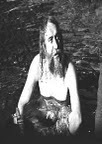miércoles, 28 de septiembre de 2011
viernes, 23 de septiembre de 2011
Penetración de "La Magia de los Sentidos" en el mundo hispano
miércoles, 21 de septiembre de 2011
Wittgensteiniano Radical: Alejandro Tomasini Bassols
sábado, 17 de septiembre de 2011
Empathy and Human Experience
| Evan Thompson Empathy and Human Experience | |
| Abstract
|
viernes, 16 de septiembre de 2011
Concierto fálico bajo el aqua
http://www.elmundo.es/elmundo/2011/07/04/ciencia/1309775977.html
BIODIVERSIDAD | Proporcionalmente es el animal más ruidoso de la Tierra
El insecto que canta 'serenatas' con el pene

Imagen de un ejemplar de 'Micronecta scholtzi'.| Universidad de Strathclyde
Elisa Piñeiro Kruik | Madrid
En el juego de la seducción no hay tácticas infalibles pero sí inverosímiles. Humanos y animales agudizan el ingenio, con el fin de conquistar al objeto de deseo. El diminuto insecto de agua dulce 'Micronecta scholtzi' apuesta por una ruidosa y llamativa técnica. Para atraer a la hembra y como parte del proceso de cortejo, el bicho canta. Pero no se trata de un canto cualquiera: es tan ruidoso que puede alcanzar los 99,2 decibelios, algo parecido a estar sentado en primera fila mientras un grupo de músicos toca en una orquesta. Sin embargo, lo verdaderamente curioso es que su pene se convierte en el instrumento para emitir la melodía.
'Micronecta scholtzi' no supera los dos milímetros, pero emite este ruidoso canto frotando el pene contra su abdomen, que tan sólo mide 50 micrómetros. No cabe duda de que es una de las técnicas de seducción más impresionantes. El hallazgo, desvelado por científicos europeos, fue publicado en la revista 'PLoS ONE'. Para grabarlo, utilizaron micrófonos submarinos. La media se situó en 78,9 decibelios, similar al ruido de un tren de mercancías.
Canto reproductivo
El canto forma parte del ritual reproductivo. Según explica Jerome Sueur, uno de los investigadores, "los machos compiten por las hembras. Intentan emitir la canción más ruidosa pasando por encima de la de sus rivales".
James Windmill, un ingeniero de la Universidad de Strathclyde que también participó en el estudio, confesó que "estaban muy sorprendidos" ya que al inicio, pensaban que el sonido procedía de un insecto más grande. Windmill reveló que el canto de estos ingeniosos bichos no nos ensordece porque viven bajo el agua y el 99% del sonido se pierde al atravesar la frontera entre el agua y el aire. Aún así, el ser humano es capaz de oírlo.
Aunque la lógica conduce a pensar que los animales grandes son los más ruidosos, los pequeños están dispuestos a desmentirlo, al menos musicalmente. El grillo, la mantis religiosa y este insecto compiten contra gigantes como la ballena azul o el elefante. Pero si tenemos en cuenta el tamaño de sus cuerpos, el ganador es el protagonista de esta historia. Windmill lo confirma: "Si se compara el sonido al tamaño de los cuerpos, 'Micronecta scholtzi' es el animal más ruidoso de la Tierra".
miércoles, 14 de septiembre de 2011
sábado, 10 de septiembre de 2011
re Vitalising Classrooms thru: ¡Music!

Like many teens, music was a big part of my life growing up. I spent countless hours listening to the radio and talking about new hit songs with friends. I even saved my allowance to buy cassette singles (yeah, remember those?) of my favorite songs whenever I could.
As a child of the 90s, hip hop was – and still is – the love of my life. I got into it late, but A Tribe Called Quest, De La Soul and The Roots quickly won me over. Hip hop (like most music genres) was more than just a genre – it was a cultural phenomenon. Yet, despite its ubiquity, it never had a place in the classroom; at least not while I was growing up.
But in the last decade or so that's changed. According to The New York Times, a new program in New York City is using that urban culture to get high school students excited and ready for their Regents Exam in American history. The program, called Fresh Prep, is run by the Urban Arts Partnership and uses beats and rhymes to help students memorize history facts in preparation for the New York Regents Exams, which students must pass in order to graduate from high school.
Sam Sellers (a.k.a. Rabbi Darkside) is a Fresh Prep instructor who has come up with 24 rap songs on global history and American history. His students can download these songs and, along with a 250-page workbook, review important history dates, events and concepts.
When I read the article, I couldn't help but wonder, how did this not catch on earlier? As a teen, my brain soaked up musical lyrics like a sponge, (in fact, I still remember most of the lyrics from the songs I grew up with) so something like this would have had a big impact on me. In high school, and even in college, history courses were challenging. And I don't mean challenging the same way calculus was, but challenging because the material was so dry and boring; it was hard to stay engaged. There was so much to remember and material was always presented in the worst way – reading old school textbooks that could never put things into context and then regurgitating what I read in the form of a report. I can't even imagine how much more boring that kind of learning must be for today's media obsessed generation.
To be clear, hip hop as a teaching tool has been around for a few years now, particularly in underserved urban areas. But the take away message here is that learning, at any age, should be fun and interactive.
Thanks to technology, the world and the way we interact with and exchange information is rapidly changing, which makes keeping things fresh and relevant a challenge within education. But programs like Fresh Prep have the right idea. If we want students to really get it, educators need to be in tune with their students and continually come up with new ways to keep old concepts interesting and relevant.
conciencia delplacer ha compartido un álbum contigo
| conciencia delplacer te ha invitado a ver una fotografía de su álbum de fotos: 10 de septiembre de 2011
|











